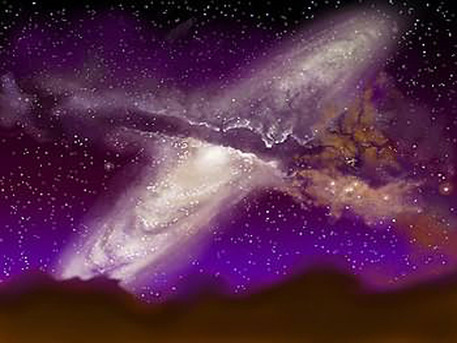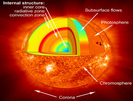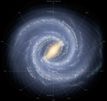The future of the Milky Way
Whither goest thou, Milky Way?
 © James Gitlin
|
This artist's impression shows the collision between the Milky Way and the Andromeda Galaxy, many billions of years in the future. This scenario is based on observed data and analytically grounded fantasy.
Worlds colliding
Observations of other pairs of galaxies that converge indicate that the Milky Way and the Andromeda Galaxy would also first 'dance around' each other in a spiral and then melt together to form a large elliptical galaxy. Nothing will happen to the stars themselves in the process, as they are light years away from each other. However, according to model calculations, their orbit around the center of the newly formed galaxy could change – from a circular orbit to an elliptical one. Gas atoms and dust from the two galaxies inevitably collide with each other and thus change their speed in relation to the stars – the new elliptical galaxy starts to lack interstellar matter from which new stars are formed.
Human beings will most probably not live to see these events (see question 'How long will the Sun continue to shine?') – if they do, however, then there is already a name for their new home galaxy: Milkomeda (from Milky Way and Andromeda).
German Aerospace Center
The future of the Milky Way
Whither goest thou, Milky Way?
 © James Gitlin
|
This artist's impression shows the collision between the Milky Way and the Andromeda Galaxy, many billions of years in the future. This scenario is based on observed data and analytically grounded fantasy.
Worlds colliding
Observations of other pairs of galaxies that converge indicate that the Milky Way and the Andromeda Galaxy would also first 'dance around' each other in a spiral and then melt together to form a large elliptical galaxy. Nothing will happen to the stars themselves in the process, as they are light years away from each other. However, according to model calculations, their orbit around the center of the newly formed galaxy could change – from a circular orbit to an elliptical one. Gas atoms and dust from the two galaxies inevitably collide with each other and thus change their speed in relation to the stars – the new elliptical galaxy starts to lack interstellar matter from which new stars are formed.
Human beings will most probably not live to see these events (see question 'How long will the Sun continue to shine?') – if they do, however, then there is already a name for their new home galaxy: Milkomeda (from Milky Way and Andromeda).
German Aerospace Center











